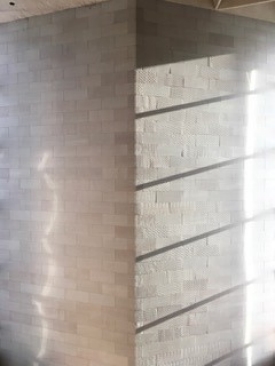Before coming to Washington, I was asked to think about which objects from the National Gallery’s collection I might talk about in relation to my research. At the time, none seemed quite perfect, but Henry Moore’s Three Motives Against Wall, Number 1 (1958) emerged as the nearest to my project. This led me to think about Moore’s particular relationship with the wall, which I have traced from his project for Marcel Breuer’s UNESCO headquarters of the same year back through his London Underground shelter drawings of 1940. This is not a common reading because it focuses on the wall rather than the figure.
Having arrived here, I have spent a lot of time in the nearly empty East Building contemplating the wall. Therese O’Malley fortunately allocated me a copy of the 2009 Studies in the History of Art volume on the East Building, which has elucidated my understanding of I. M. Pei’s approach to its fabrication. I have also benefited from being able to visit contemporaneous examples in Washington, which Pei himself took note of, notably Victor Alfred Lundy’s Tax Court down the road. Tony Smith’s She Who Must Be Obeyed (1975), alongside, is also pertinent.
Thus an area of interest which began with highly textured wall treatments—such as those in the Fosse Ardeatine (Rome), Mémorial des Martyrs de la Déportation (Paris), and Yale Art and Architecture Building (New Haven), and their links to sculptural reliefs by Jorge de Oteiza, Costantino Nivola, and Moore—has, in Washington, gravitated almost naturally to the very opposite, to an almost illusory wall surface, an image or design, largely without texture. To a degree, this has brought me also to painting and to the painted surface, as found, perhaps most clearly, in a sculptor like Anne Truitt, whose work I have examined in situ at the National Gallery and the National Museum of Women in the Arts.
The Library’s excellent American holdings have allowed me a much deeper look at the sculptors who worked alongside the more famous representatives of minimal art. Understanding the diversity of the artists making “unitary” forms in the early and mid-1960s has been useful to a British scholar who normally encounters a much narrower range. Faced with a wider sample, I see that there is indeed a shared lightness and hollowness to their work. In this they are less like Anthony Caro, and more like the other British sculptors who were lucky enough to be included in that famous Primary Structures exhibition of 1966 at the Jewish Museum in New York.
I hope to write this up as a reflection on the physical and visual experience of the wall during and after World War II, demonstrating a shift from the sheltering wall to the memorial or didactic wall, and thence to the illusory or image-based structure. I believe that these phases, despite their contrasts, share a surface that is extensive, even endless—and that its facture as well as its form can be seen as shared across sculpture and architecture in ways that have not yet been fully articulated.
Having now completed two terms as director in two very different museums (Tate Britain and Museu Calouste Gulbenkian), I hope in the Edmond J. Safra Colloquy to bring to bear some of my experience in rethinking collections in relation to institutional histories and architecture. Tate Britain shares an architect, John Russell Pope, with the National Gallery of Art; that “American” space is also at the heart of British art.
London
Edmond J. Safra Visiting Professor, spring 2021
Penelope Curtis plans to write up this material while preparing an exhibition about scale in sculpture for the Fundación Juan March in Madrid, opening in March 2023.


